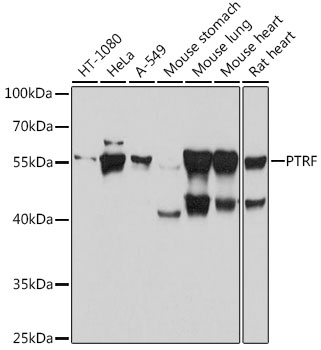Cell Biology Antibodies 18
Anti-PTRF Antibody (CAB18331)
- SKU:
- CAB18331
- Product Type:
- Antibody
- Reactivity:
- Human
- Reactivity:
- Mouse
- Reactivity:
- Rat
- Host Species:
- Rabbit
- Isotype:
- IgG
- Research Area:
- Cell Biology
Description
| Antibody Name: | Anti-PTRF Antibody |
| Antibody SKU: | CAB18331 |
| Antibody Size: | 20uL, 50uL, 100uL |
| Application: | WB IHC IF |
| Reactivity: | Human, Mouse, Rat |
| Host Species: | Rabbit |
| Immunogen: | Recombinant protein of human PTRF. |
| Application: | WB IHC IF |
| Recommended Dilution: | WB 1:500 - 1:2000 IHC 1:50 - 1:200 IF 1:50 - 1:200 |
| Reactivity: | Human, Mouse, Rat |
| Positive Samples: | HT-1080, HeLa, A-549, Mouse stomach, Mouse lung, Mouse heart, Rat heart |
| Immunogen: | Recombinant protein of human PTRF. |
| Purification Method: | Affinity purification |
| Storage Buffer: | Store at -20°C. Avoid freeze / thaw cycles. Buffer: PBS with 0.02% sodium azide, 50% glycerol, pH7.3. |
| Isotype: | IgG |
| Sequence: | Email for sequence |
| Gene ID: | 284119 |
| Uniprot: | Q6NZI2 |
| Cellular Location: | |
| Calculated MW: | 43kDa |
| Observed MW: | 55kDa |
| Synonyms: | CAVIN1, CAVIN, CGL4, FKSG13, PTRF, cavin-1 |
| Background: | This gene encodes a protein that enables the dissociation of paused ternary polymerase I transcription complexes from the 3' end of pre-rRNA transcripts. This protein regulates rRNA transcription by promoting the dissociation of transcription complexes and the reinitiation of polymerase I on nascent rRNA transcripts. This protein also localizes to caveolae at the plasma membrane and is thought to play a critical role in the formation of caveolae and the stabilization of caveolins. This protein translocates from caveolae to the cytoplasm after insulin stimulation. Caveolae contain truncated forms of this protein and may be the site of phosphorylation-dependent proteolysis. This protein is also thought to modify lipid metabolism and insulin-regulated gene expression. Mutations in this gene result in a disorder characterized by generalized lipodystrophy and muscular dystrophy. |
| UniProt Protein Function: | PTRF: Plays an important role in caveolae formation and organization. Required for the sequestration of mobile caveolin into immobile caveolae. Termination of transcription by RNA polymerase I involves pausing of transcription by TTF1, and the dissociation of the transcription complex, releasing pre-rRNA and RNA polymerase I from the template. PTRF is required for dissociation of the ternary transcription complex. Defects in PTRF are the cause of congenital generalized lipodystrophy type 4 (CGL4). It is a disorder characterized by the association of congenital generalized lipodystrophy with muscular dystrophy and cardiac anomalies. Congenital generalized lipodystrophy is characterized by a near complete absence of adipose tissue, extreme insulin resistance, hypertriglyceridemia, hepatic steatosis and early onset of diabetes. Belongs to the PTRF/SDPR family. 3 isoforms of the human protein are produced by alternative splicing. |
| UniProt Protein Details: | Protein type:Transcription initiation complex Chromosomal Location of Human Ortholog: 17q21.2 Cellular Component: nucleoplasm; protein complex; mitochondrion; intracellular membrane-bound organelle; endoplasmic reticulum; cytoplasm; plasma membrane; caveola; cytosol; nucleus Molecular Function:protein binding; rRNA primary transcript binding Biological Process: regulation of transcription, DNA-dependent; transcription from RNA polymerase I promoter; gene expression; termination of RNA polymerase I transcription; transcription initiation from RNA polymerase I promoter Disease: Lipodystrophy, Congenital Generalized, Type 4 |
| NCBI Summary: | This gene encodes a protein that enables the dissociation of paused ternary polymerase I transcription complexes from the 3' end of pre-rRNA transcripts. This protein regulates rRNA transcription by promoting the dissociation of transcription complexes and the reinitiation of polymerase I on nascent rRNA transcripts. This protein also localizes to caveolae at the plasma membrane and is thought to play a critical role in the formation of caveolae and the stabilization of caveolins. This protein translocates from caveolae to the cytoplasm after insulin stimulation. Caveolae contain truncated forms of this protein and may be the site of phosphorylation-dependent proteolysis. This protein is also thought to modify lipid metabolism and insulin-regulated gene expression. Mutations in this gene result in a disorder characterized by generalized lipodystrophy and muscular dystrophy. [provided by RefSeq, Nov 2009] |
| UniProt Code: | Q6NZI2 |
| NCBI GenInfo Identifier: | 56749614 |
| NCBI Gene ID: | 284119 |
| NCBI Accession: | Q6NZI2.1 |
| UniProt Secondary Accession: | Q6NZI2,O00535, Q6GMY1, Q96H74, Q9BT85, Q9HAP4, B2RAW7 |
| UniProt Related Accession: | Q6NZI2 |
| Molecular Weight: | 390 |
| NCBI Full Name: | Polymerase I and transcript release factor |
| NCBI Synonym Full Names: | polymerase I and transcript release factor |
| NCBI Official Symbol: | PTRF |
| NCBI Official Synonym Symbols: | CGL4; CAVIN; CAVIN1; FKSG13; cavin-1 |
| NCBI Protein Information: | polymerase I and transcript release factor; PTRF; TTF-I interacting peptide 12; RNA polymerase I and transcript release factor |
| UniProt Protein Name: | Polymerase I and transcript release factor |
| UniProt Synonym Protein Names: | Cavin-1 |
| Protein Family: | Polymerase I and transcript release factor |
| UniProt Gene Name: | PTRF |
| UniProt Entry Name: | PTRF_HUMAN |







